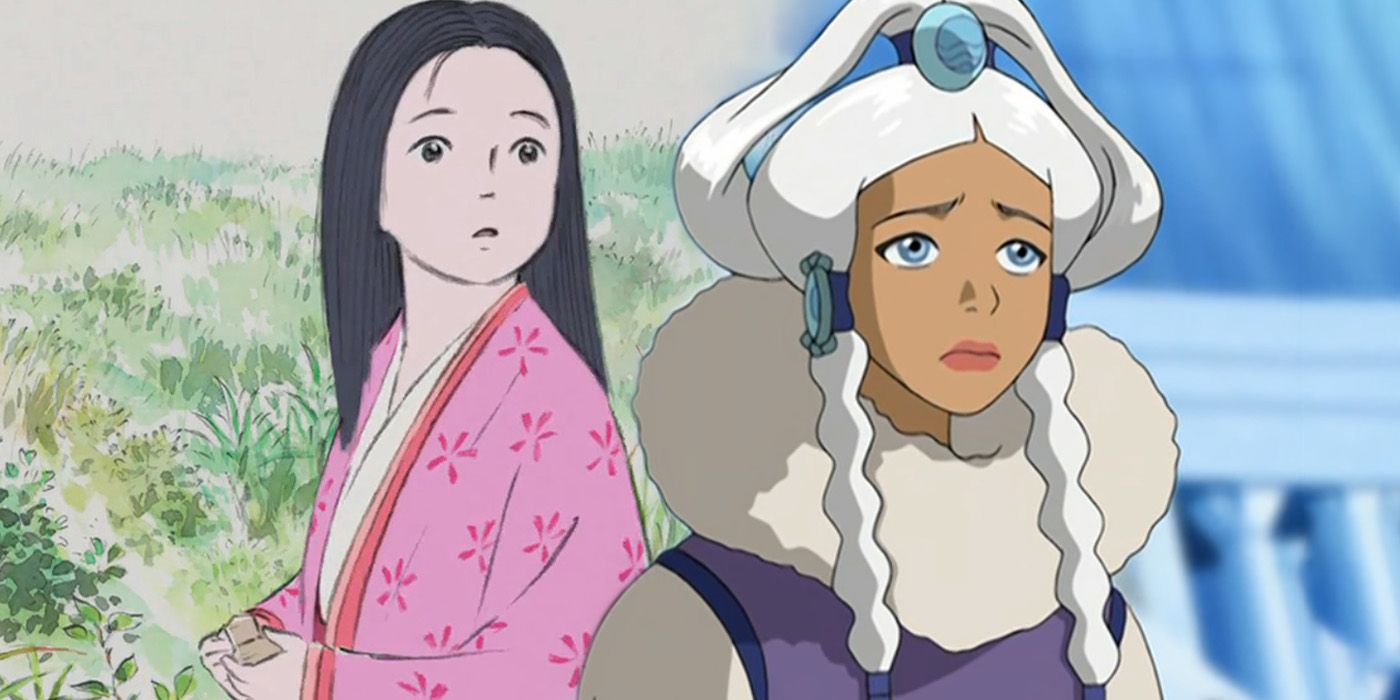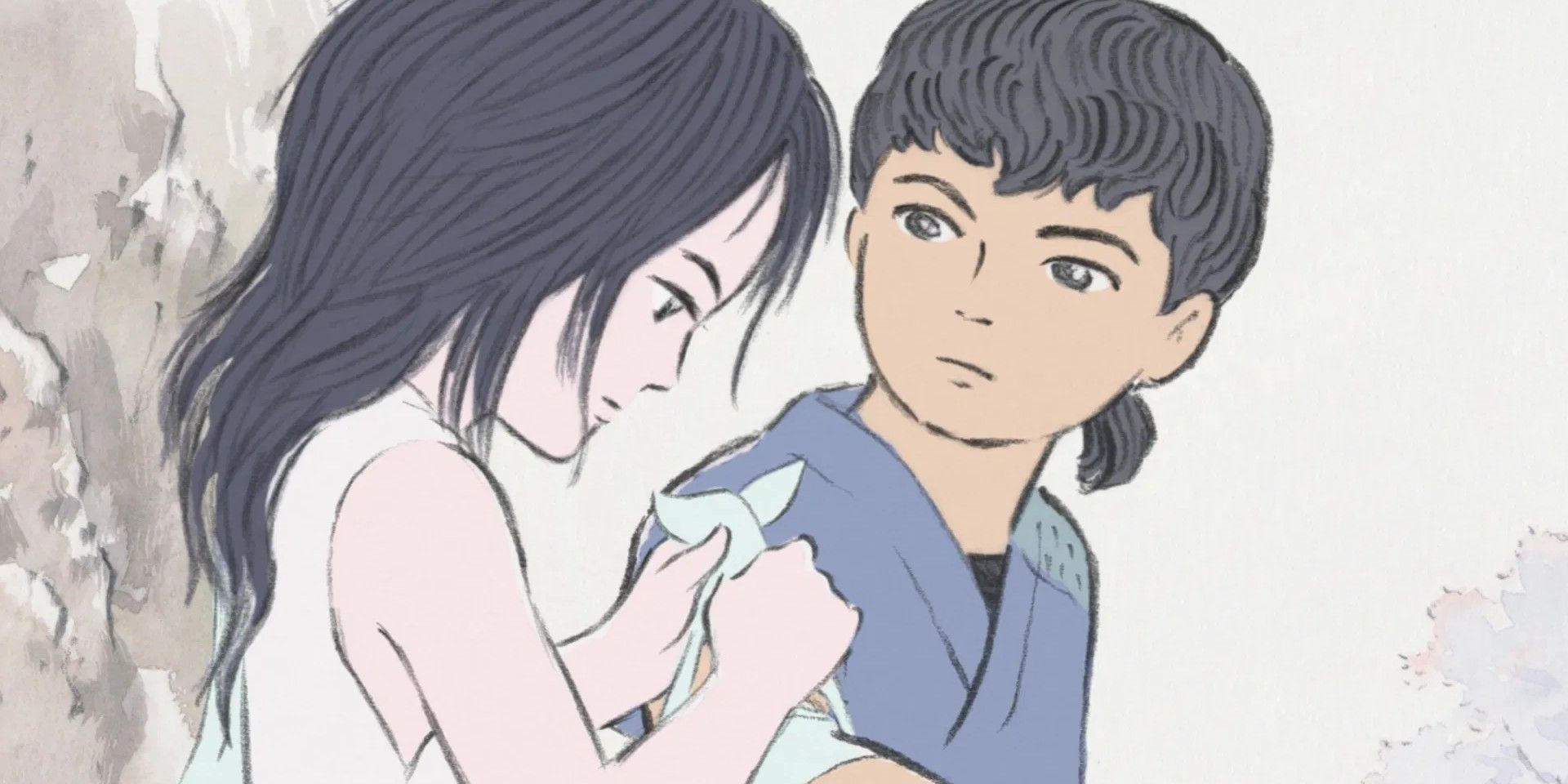
The sacrifice of Princess Yue is one of Avatar: The Last Airbender's saddest moments, and it shares its source material with a Studio Ghibli film, The Tale of Princess Kaguya. Directed by the late Isao Takahata (who also directed Ghibli's better-known tearjerker Grave of the Fireflies), The Tale of Princess Kaguya is based on a classic Japanese story called The Tale of the Bamboo Cutter.
Though it was produced in the US, Avatar's world draws greatly upon the culture, history, and philosophy of Asian countries. The Fire Nation, for example, is mostly based on Imperial Japan, and the Earth Kingdom city of Ba Sing Se was inspired by the walled city of Beijing. The Northern and Southern Water Tribes are modelled on Inuit and Sireniki cultures, but the story of the princess who came from the moon and later returned to it is Japanese in origin.
Avatar creators Michael Dante DiMartino and Bryan Konietzko have never explicitly said that Princess Yue's story is based on The Tale of the Bamboo Cutter, but the resemblance is uncanny. Given the depth of research that went into the show, it's unlikely that they'd be unaware of one of Japan's most famous folk tales. Here's what happens in the original story, and how it compares to Yue's arc in Avatar and Takahata's adaptation.

One day a poor bamboo cutter came across a bamboo reed with a mysterious light shining from it. After cutting it down, he found a tiny little girl inside the reed, just a few inches tall. The bamboo cutter brought the little girl home to his wife and they decided to raise her as their own daughter, having never had any children of their own. The little girl grew to a normal size in just three months, and when the bamboo cutter returned to cut more bamboo he found the stalks were filled with gold. He decided that the little girl must be a princess, and gave her the name Princess Kaguya.
Using the gold from the bamboo, the bamboo cutter built a fine house and became a very wealthy man. He carefully hid Princess Kaguya away from the world, which only made people more curious to see her. Eventually the bamboo cutter decided that he must find a worthy husband to take care of his beloved princess after his death, and five suitors came to the house. Princess Kaguya, however, had no interest in getting married. In an attempt to drive the suitors away, she tasked each of them with bringing her an extremely rare legendary treasure. All of them failed, but the Emperor then also fell in love with her and began begging for her hand in marriage.
Throughout all of this the princess grew more and more sad, and her parents noticed her staring up at the moon and weeping. Eventually she explained to them that she had come down to earth from the moon, and that soon her people would come to take her home again. The bamboo cutter fortified the house and amassed many fighters to defend Princess Kaguya from the moon-folk, but all of his efforts proved useless. The Tale of the Bamboo Cutter ends with the princess returning to the moon on a flying chariot, with her heartbroken human parents tearfully watching her leave.

Avatar: The Last Airbender's Princess Yue is different from the Princess Kaguya in some ways. She was born normally (not found in a bamboo cane) and her parents were not poor bamboo cutters, but the Northern Water Tribe's Chief Arnook and his wife. When Yue was a baby she became very sick, and none of the tribe's healers could help her. Desperate to save his daughter, Arnook placed her in the Spirit Oasis and asked the Moon Spirit - embodied by the black koi fish La and the white koi fish Tui - to save her life. The Moon Spirit gave Yue part of its own life force, which turned her hair white.
Yue is introduced towards the end of Avatar: The Last Airbender season 1, when Team Avatar arrives at the Northern Water Tribe in search of a master to train Aang in waterbending. She immediately catches Sokka's eye and - much like the suitors in The Tale of the Bamboo Cutter - he becomes desperate to talk to the beautiful but off-limits princess. Sokka learns that Yue is betrothed to a young Northern Water Tribe warrior called Hahn, but doesn't really love him and is only trying to fulfil her parents' expectations of her. It's here that the similarities between Yue and Kaguya become particularly apparent: both feel trapped into an unhappy life that they cannot escape without upsetting their parents.
Like Kaguya, Yue is spared from an unwanted marriage by another tragedy. After General Zhao kills La, turning the moon dark and robbing all waterbenders of their powers, Yue decides to restore the Moon Spirit by giving back the life force it once gave to her. Her mortal body dies in Sokka's arms and she becomes the embodiment of the Moon Spirit. Though she made her last physical appearance in Avatar's season 1 finale, Yue's presence is felt throughout the rest of the series, appearing to Aang in a spirit form and to Sokka as a hallucination. Moreover, because waterbenders draw their power from the moon, she continues to help Team Avatar for their rest of their journey.

The Tale of Princess Kaguya is well worth watching for fans of Yue's story in Avatar: The Last Airbender, who would like to see a much less abridged version of it. Perhaps the true tragedy of the film is that it's one of Studio Ghibli's lesser-known works, despite being highly praised (it holds a critic score of 100% and an audience score of 90% on Rotten Tomatoes). It features painstakingly hand-drawn animation with watercolor backgrounds, giving it a dreamy quality befitting of a fairy tale.
Takahata's film is a much closer adaptation of the original story when compared to Yue in Avatar: The Last Airbender, but it also features some embellishments of its own. Among these is the addition of a true romantic interest for Kaguya, Sutemaru, whose love for her is as doomed as Sokka's was (Sutemaru is always shown dressed in blue, which makes the parallel all the more striking). The Tale of Princess Kaguya particularly highlights the contrast between the simple, happy and free life that Kaguya wants to lead and her father's misguided efforts to do what he think is best for her. Unlike the original story, where Kaguya's time on earth simply comes to an end, in the film the princess actually becomes so unhappy that she prays to the moon-folk to take her back. Returning to the moon also wipes all her memories of her life on earth, so she won't even remember the parents who raised and loved her.
What really makes The Tale of Princess Kaguya so powerful are its scenes of overwhelming beauty and joy, which create the impression that the story will have a happy ending (in contrast to the bleakness of Grave of the Fireflies). Though Avatar's take on the story of the moon princess may have been much more condensed, fans still felt that same hope that Yue might follow her heart and leave her responsibilities behind to be with Sokka - making it that much harder when their story ended in tragedy.
-
Though it draws greatly from cultures, architecture and martial arts styles across Asia, Avatar: The Last Airbender is a highly original show that mostly avoids direct adaptations of any particular myths and legends. Instead there are allusions to familiar stories - like the Foggy Swamp waterbender Huu, who claims to have achieved enlightenment by sitting underneath a banyan-grove tree (a nod to the story of the Buddha). Princess Yue's story, though it takes place over just three episodes, still captures much of what made The Tale of the Bamboo Cutter so enduring.
from ScreenRant - Feed https://ift.tt/33BHeWp






0 Comments
Please don't use vulgar comments and avoid discussion on Religious matters